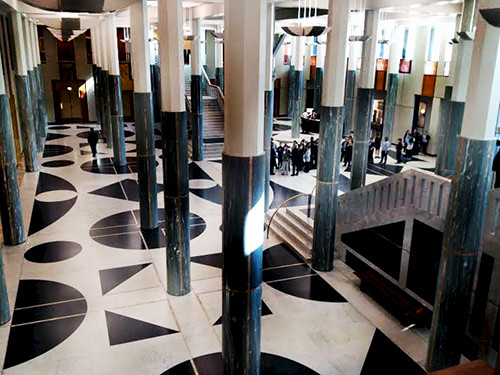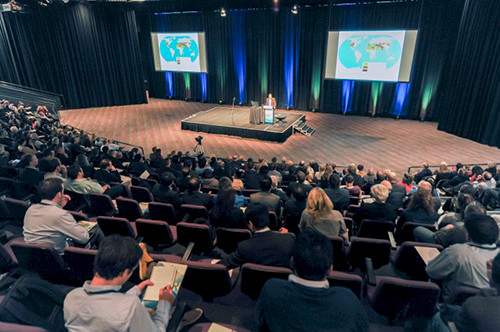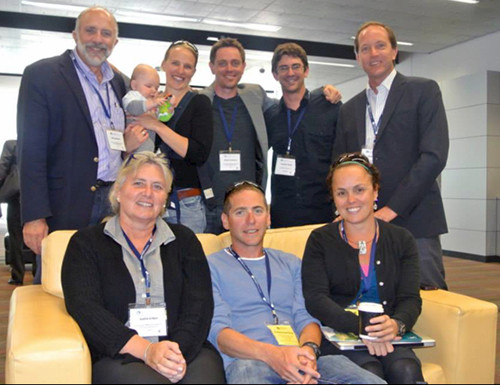2014 International Riversymposium
Bill Dennison ·Simon Costanzo, Heath Kelsey, Dave Loewensteiner, Judy O’Neil, Jane Thomas and I attended the 17th Annual International Riversymposium in Canberra, Australia, 15-18 September 2014. The theme of this year’s symposium was ‘Large River Basins’ which was quite topical for the IAN team completing the draft Mississippi River report card. The location of the symposium in Australia’s capital city Canberra was appropriately within the largest river basin on the continent, the Murray-Darling River. I took advantage of the Canberra setting to visit Parliament House, the seat of government for Australia.


Nick Schofield, the CEO of the International RiverFoundation, welcomed us to Canberra, which is derived from an aboriginal Australian word for ‘meeting place’, apropos of our gathering together for the conference. Sallyanne Atkinson, former Lord Mayor of Brisbane and the interim chair of the International Riversymposium acknowledged the many sponsors and mentioned that Brisbane was the only state capital in Australia named after a river, a fact that I had not realized even after living in Brisbane for ten years. Mick Gentleman, a member of the Australian Capital Territory Legislative Assembly, provided a historical perspective of Canberra and highlighted the fifty-year anniversary of Lake Burley Griffin, an offshoot of the Murrumbidgee River.

The conference keynote talk was by Brian Richter from The Nature Conservancy. He talked about ‘Rivers running dry: Seeking sustainability in a world of change’, based in large part on his new book ‘Chasing Water: A guide for moving from scarcity to sustainability’, Island Press. Brian talked about river hydrograph regimes as links to species and ecoprocesses. He equated the river flow to a “Maestro of the river symphony”. Brian talked about the ongoing and impending water shortages globally, with ecological, economic and security implications. What I really liked about Brian’s talk was the emphasis on solutions. He listed the six ways to fix water shortages, in order of increasing costs as the following: 1) water conservation, 2) watershed management, 3) water storage, 4) water importation, 5) water reuse, and 6) desalinization. Some of the costly examples included Saudi Arabia’s reliance on desalinization associated with energy use, a planned 1000 km pipe in China to transport water and a project to reverse a river uphill (up to 1280 m altitude) covering the distance of the U.S. continent. Brian also provided a recipe for preventing water shortages: 1) Set sustainable limits on water extractions, based on reliable water availability, ecological needs, while hedging against climate change, 2) Reduce consumption to sustainable levels, 3) Quantify rights to use water, and 4) Enable trading among water rights holders, so that water can be purchased by those who need it and to incentivize water conservation. Brian pointed out that the present system in the U.S. of historical water rights allocations incentivizes water consumption and does not allow for market forces to be used. Brian finished off with a great success story of the flow of the Colorado River into the Sea of Cortez, the first time this has occurred in 35 years.


The conference featured three case studies of globally iconic rivers; The River Rhine (which went on to win the International Riverprize), the Murray-Darling River basin, the Mekong River. In the Mekong presentation, the panel of speakers symbolically held hands and then had the audience come and join them in a group Cambodian dance at the end of the session. I also enjoyed learning about the Niger River in Africa and the Hindu Kush-Himalayan region which serves as “Mountain Water Towers” for ten major river basins in Asia with 1.3 billion people living directly downstream from these towers. An unusual, but interesting, feature of the conference was the use of speed posters, in which one to three slides were used in a five-minute presentation. These posters also were projected on a rotating carousel in the poster/exhibit/food room.

There are several aspects about the International Riversymposium that bring me back every year: 1) I enjoy that celebration of world’s best practice for river management, manifested in the Riverprize gala dinner, 2) The emphasis on practical solutions, rather than documenting the problem is refreshing, 3) The case studies give me a better idea of what is happening in the world’s rivers, 4) The international plenary speakers (e.g., Bob Costanza, Stuart Bunn, Bob Naiman, Dipak Gyawali) provided thought-provoking and interesting talks, and 5) I really enjoy the networking opportunities to connect with practitioners from around the world.
About the author
Bill Dennison

Dr. Bill Dennison is a Professor of Marine Science and Vice President for Science Application at the University of Maryland Center for Environmental Science.
Next Post > Mississippi report card video
Comments
-
Student In Australia 11 years ago
Thanks Bill for sharing the post. Great to learn about the Riversymposium this year and looking forward for the 2015.